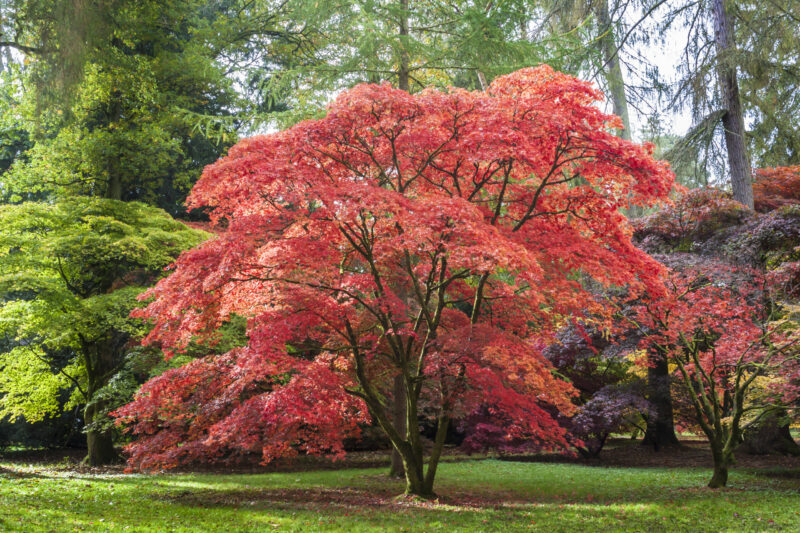Ace your acer

Commonly known as maples, there’s a multitude of acers available. We shortlist the best picks by size. Words: Gillian Vine, Photos: Getty Images.
SWEET & PETITE (1–3m)
As gardens have become smaller, the demand for – and breeding of – smaller decorative trees and shrubs has exploded.
At the same time, year-round appeal is important, so acers (commonly called maples), with their brilliant spring and autumn foliage and elegant trunks when the leaves fall, fit the trend to perfection. All need shelter from strong winds and most prefer moist, slightly acid soil, so forget the lime.

For those looking for the truly tiny, an Acer makes an excellent bonsai specimen. The advantages are being able to shape the tree into one of the dozen classical shapes and enjoy a close-up view of the changing seasons. I have seen a Japanese maple (Acer palmatum) trained in the multi-trunked Kabudachi style but, for the beginner, the formal upright (Chokkan) or slanting/leaning (Shakan) styles would be easier to manage.
A step up from bonsai are the lace-leafed maples, A. palmatum var. dissectum, growing 1–3m tall and available in upright or weeping forms. Both have orange and red autumn foliage. ‘Garnet’ has purple foliage.
There are other hardy dwarf Japanese maples worth considering: A. palmatum ‘Shigitatsu Sawa’ (2m) is a subtle charmer, while ‘Skeeters Broom’ is one of the best for ongoing colour, with bright red spring leaves maturing to burgundy in summer, then scarlet in autumn.
Known as the Oregon vine maple, North American A. circinatum has the prettiest pinkish-red seed heads (known as samara or keys, which appear wing-like). A. circinatum ‘Little Gem’ is a near-perfect baby, growing 1m by 1m and therefore ideal for containers and rock gardens.
MIDDLE GROUND (5–10m)
The bulk of the medium-sized acers include many of the hundreds of A. palmatum varieties, although the coliseum maple (A. cappadocicum) and its cultivar ‘Rubrum’ fit in here, as do the Taiwan maple (A. caudatifolium), A. davidii – named for the French missionary who collected it in China – the Japanese golden full-moon maple (A. shirasawanum), the Canadian red maple (A. rubrum), the slow-growing A. pseudoplatanus ‘Brilliantissimum’, which rarely tops 5m, and the seldom seen A. henryi.
With such a line-up, the challenge is what to grow. Leaf colour tends to dominate choices, so consider these options.
Green leaves
- A. rubrum ‘Autumn Glory’ (sometimes called ‘October Glory’) is green from spring until autumn, then the foliage turns crimson, with the leaves usually holding on into winter.
- The paperbark maple (A. griseum) is more usually grown for its flaky bark but has soft green leaves that colour nicely in April or May.
- Especially striking are A. palmatum var. dissectum ‘Viridis’, with its weeping growth and finely cut lime-green foliage; A. shirasawanum, which has unusually shaped leaves; and snakebark maple A. conspicuum ‘Silver Vein’, for winter appeal.

Red or purple leaves
Try A. rubrum, A. negundo ‘Violaceum’, A. palmatum ‘Bloodgood’, A. palmatum ‘Atropurpureum’ or A. platanoides ‘Crimson King’.
Yellow leaves
Opt for A. palmatum ‘Aureum’, the golden sycamore A. pseudoplatanus ‘Worley’, A. negundo ‘Elegans’ or A. palmatum ‘Orange Dream’.
Variegated leaves
For variegation, try A. pseudoplatanus ‘Leopoldii’, A. negundo ‘Variegatum’, A. negundo ‘Flamingo’ and A. pseudoplatanus ‘Esk Sunset’ (aka ‘Eskimo Sunset’), a New Zealand ‘find’ of the 1980s.
THE BIG BOYS (10–35m)
Let’s get the thug out of the way first. That’s the common sycamore (A. pseudoplatanus), a European species that can grow 35m or more and spreads its keys far and wide. In the Dunedin area, it has been declared a pest plant.
As alternatives to the sycamore, consider golden A. cappadocicum ‘Aureum’, the downy Japanese maple (A. japonicum) or a Norway maple (A. platanoides).
Snakebark maples are distinguished by their striped bark that often rivals their leaves for colour. With one exception, they are Asian species that grow into large trees. The Forrest’s maple (A. forrestii), from China, is quite rare but lacks the vivid red autumn foliage of another Chinese species, Hers’s maple (A. hersii). The red snakebark (A. capillipes) from Japan also decks itself in red and orange at the end of summer. The odd one out is moosewood (A. pensylvanicum). Not only is this snakebark North American but it tends to be smaller (6m) and the beautiful striped bark tends to go warty as the tree ages. It has yellow autumn colour.
If you fancy trying your hand at making maple syrup, the North American sugar maple (A. saccharum) is the one to grow. Silver maple (A. saccharinum) also produces a sweet juice, but it is considered inferior.
Did you know?
Some maples are dioecious, having separate male and female forms. Pollen from male silver maples and
A. negundo can produce severe allergic reactions, while both sexes of the Norway maple, sycamore and the paperbark maple can cause allergic rhinitis (hay fever). So maybe avoid those when selecting your maple tree!

